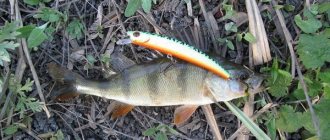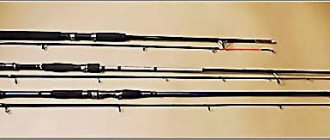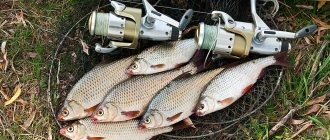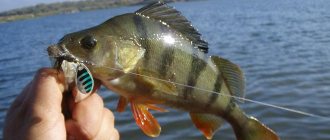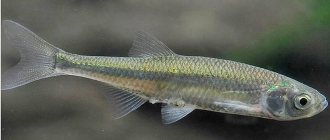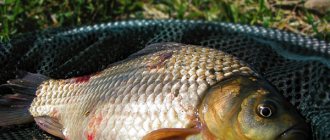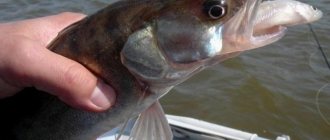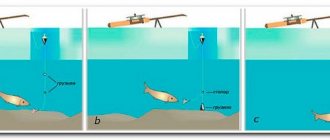Selecting a location
The nature of the “striped” habitat directly depends on the type of reservoir and time of year. In small shallow rivers, perch prefers to stay in places with no current:
- in coastal pools;
- behind the pitfalls;
- on bends;
- in the creeks.
In lakes and reservoirs, “striped” should be looked for at a depth of 2 to 4 m, on sand spits and underwater hills. The coastal zone of standing reservoirs, as a rule, is inhabited by small grass perches, rarely reaching a mass of more than 100 g. On large rivers, perch adheres to:
- coastal dumps;
- channel edges;
- stuck areas;
- places with sharp changes in depth.
The bays and oxbows of large rivers are the permanent habitats of this predator. When fishing, you should pay attention to fry jumping out of the water and clusters of terns above the water, as this is a sure sign that the striped fish is fattening. The effectiveness of fishing largely depends on the angler’s knowledge of the river’s bottom topography.
In the spring, when the water has not yet warmed up, perch hunts at depths of no more than one and a half meters, where the greatest concentration of fry and other food items is observed. As the water warms and aquatic vegetation grows, the fry moves to areas with a depth of 1.5–3 m, followed by perch. Catching perch in the summer with a float rod involves constantly changing places.
With the autumn cooling of the water, the “striped” one moves to places with depths of 4 to 7 m, where it remains until spring. Small grass perch does not leave the coastal zone throughout the year and is consistently caught using float gear.
Timing
Spring is the best time to catch perch with a float. At the beginning of May, the perch begins to eat, and it greedily rushes to the bait offered to it. In spring there is no need to come to the pond with the first rays of the sun. It is better to start fishing at 7–8 o’clock in the morning, when the sun warms up the coastal shallows and the fry come out of their night shelters. In the summer months, the behavior of the “striped” is changeable. The fish bite is greatly influenced by:
- Atmosphere pressure;
- water temperature;
- water level in the reservoir;
- other natural factors.

During the summer, the predator shows increased activity at dawn. The bite begins at sunrise and continues until 8–9 am. For fishing, it is better to choose quiet, cloudy days.
In the fall, the “striped” gathers in large flocks and begins to actively feed, stocking up on fat for the winter. Catching perch in the fall with a float rod can be very productive. If the angler managed to find a school of predator, then a good bite can continue throughout the daylight hours. Perch is a typical diurnal predator, feeding only during daylight hours. Captures of it at night are extremely rare.
Tackle
Various types of float gear are used for perch fishing. In the spring and summer, when the fish stands a short distance from the shore, a classic fly rod with blind equipment, 5–8 m long, is suitable for fishing for “striped fish”. This equipment allows you to make precise casts and quickly transfer the equipment.

For autumn perch fishing, it is better to use a match rod equipped with a spinning reel. Since fishing is carried out at a considerable distance from the shore, the reel must have a large additional number of bearings, which will allow you to quickly reel in the equipment. With the help of match gear, an angler can cast the equipment 40–50 m from the shore, significantly expanding the range of fishing.
When fishing in the current, a Bolognese fishing rod is used, which allows for good control of the tackle during fishing. Plug-in float tackle is rarely used for targeted fishing of perch, since it is designed for stationary fishing and does not provide for constant movements around the reservoir.
Preparing a float rod for catching perch
Choosing the right fishing rod is not that difficult. It's up to you to decide which is more convenient for you. Some people fish with fly rods from four to seven meters long, without a reel, others prefer a match stick four meters long. There is a spinning reel on it. The difference is that with a match fishing rod you can cast the bait much further, while the limit of the fly fishing rod is twenty meters. The reel has one more advantage - the presence of a friction clutch, which is very helpful in situations when large fish bite and need to be fished out.
A match fishing rod is suitable for both a pond and a large river. And if your goal is exclusively small ponds and lakes, then a flywheel will be enough.
- In 90% of cases, blind equipment is used, because it is extremely rare that situations arise when the depth of the hook exceeds a meter. Therefore, it is worth setting the fishing depth from 70 cm to a meter.
- Leashes are not required.
- The hook is placed 39 cm from the last sinker.
Read: Fishing with a winter float rod
In most cases, this simple method produces results. The important thing is to just find a good place. Because if the fish in the pond are tight, or the period is not right, you can waste time and nerves and not catch anything.
Equipment
In perch fishing, the correct construction of equipment plays a decisive role. The fly rod equipment consists of the following elements:
- main line with a diameter of 0.14–0.16 mm;
- float with a load capacity of 1.5–3 g;
- main set of weights;
- sinkers;
- leash 15–20 cm long, diameter 0.10–0.14 mm;
- hook No. 16–8 (according to international classification).
The equipment is attached to the fishing rod using a special connector fixed at the end of the fishing rod. The thickness of the main line and leader is selected taking into account the size of the expected prey.
The carrying capacity of the float depends on the depth at the fishing site and the strength of the wind. The greater the depth and the stronger the wind, the greater the carrying capacity. The sinker-reinforcer is attached to the main line at the point of its connection with the leash, and the main mass of the sinkers is located 70 cm higher. This distribution of the load ensures natural immersion of the bait and does not scare away cautious fish.
The leash is attached to the main line using the “loop-to-loop” method. The size of the hook depends on the type of bait used. For fishing on a worm or fry, a hook No. 10–8 is suitable. If bloodworms or maggots are used as bait, the hook size should not exceed No. 12.
The equipment of a match rod differs from the fly version in the design of the float and its load capacity. The match float has its own partial load, which is built into the body of the float. This float has a long body and one attachment point, which has a positive effect on casting distance. Long-distance fishing allows the angler to count on catching a large predator. The rigging of a Bolognese fishing rod for currents is no different from a fly fishing rod.
Fishing methods and gear
It is quite appropriate to say that the described fishing spots and the area shown in the photo are excellent for jig fishing. But the ice and snow lying in the spring, the years - the bastards no longer allow galloping along the shore. And therefore, we wait for the shore to be completely cleared of ice, armed with a float rod.
We choose a fishing rod according to the situation. It’s good when the fishing spot is known from the beginning. Otherwise, you have to take one thing so as not to be fully loaded.
The fly rod is good, light and sensitive, but not always suitable for use in the spring. It is not always possible to catch short. You can specially purchase a telescopic rod 7 meters long, but soon everything will change and the main fishing tool will become a spinning rod. And they get perch and toothy pike.
A four to five meter rod with a spinning reel is just right. Even a cheap Chinese one will do. The main thing is not heavy and with a soft, not “snotty” whip. This can be caught with a worm or, if necessary, replacing the fishing line with equipment, attach a live bait.
Classic tackle for catching perch with a float rod
Worm fishing in the spring always brings results, regardless of the season. However, perch is often picky. Changes in weather, “ice-borne” illness or daily activity of the sun - it’s difficult to give a clear answer. But having additional live bait with you is more than appropriate. Maggot, a purchased bag of bloodworms, a caught caddisfly - everything will be used.
I'm not smart about the equipment. The main monofilament line averages 0.14 - 0.16, leads 0.10. A pair of number 18 hooks and, of course, a float with a sinker.
Perch under half a kilogram rarely sits on a float rod, so I don’t roughen the tackle. And a thin line floats less in the wind.
If there is an active perch in the fishing area, use a “fall” retrieve. When the perch is inactive, I start feeding it.
The bait is simple. Worms chopped right on the shore and bloodworms brought in, mixed with river sand. I won’t offer flavorings to perch. This is enough. The sand creates enough turbidity at the fishing point and attracts the attention of the fish, and the presence of an animal additive is a great turn-on for striped fish. And not only him. The by-catch always includes small sorog and dace. In the spring, you need to look for this large sorog at a distance from the shore, using a running bottom with a heavy load.
Bait, with a complete absence of current or with minimal presence, is thrown by hand. Fishing takes place close to the shore.
Spring perch using live bait
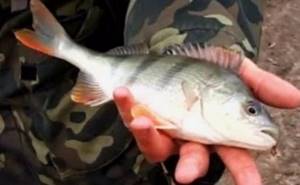
Catching perch with live bait in the spring makes sense if there are a lot of large fish at the fishing point. There is joy when you come across a flock of decent individuals.
A reel with fishing line and stored settings are always in the backpack, and changing equipment is a matter of minutes. However, so that the perch does not move away during the shift, I immediately feed the point generously. If initially perch fishing was carried out with a regular float rod, then I place the caught “malkodavs” suitable for the role of live bait in a separate container.
This is where a rod taken with a reserve of power comes in handy. Catching humpbacks up to a kilogram is not a common activity, but it is always possible.
A thicker line is wound on the spool. On average 0.18 - 0.2 mm.
All equipment consists of a float, a lead sinker and a single hook number 4 or 6 according to foreign classification.
I use homemade floats made of dense foam, with one attachment point to the fishing line. I paint the antenna bright red. Even covered with ice, it is clearly visible on the pond.
I select floats depending on the size of the live bait, the depth of the reservoir and the state of the current.
I place the load so that the bait is located near the bottom or closer to the middle of the depth.
I attach very small baitfish by the lips, larger ones - through the gills.
Fishing is simple but interesting. Using a pendulum cast, I send the bait to the point and wait about five minutes. If there is no bite, I throw it a little to the side. Usually, a humpback whale that has shown itself does not keep you waiting long. A splash, dangling live bait with a small amplitude provokes an attack.
By the way, catching perch with a float rod equipped with a worm or live bait brings results not only in the spring. At the end of summer, when the mature young stripers begin to chase the fry, live bait fishing always allows you to catch real humpback whales.
NHNCH. Kolobkov A.N. Kodinsk
Baits
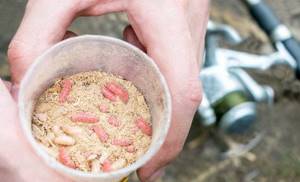
Perch is a predatory fish, so it should be caught using bait of animal origin. The most common baits when fishing for “striped” include:
- worm;
- fry;
- maggot;
- bloodworm.
Catching perch with a worm is more effective on rivers, since the fish are accustomed to the fact that during high water periods worms enter the water in large numbers. Whitebait is a universal bait that works well throughout the entire period of open water.
Maggot - used as independent bait, as well as as an addition to bloodworms or worms. Perch reacts better to brightly colored maggots. The procedure for staining larvae consists of several stages:
- the larvae are placed in a deep container and moistened with water;
- the moistened maggot is sprinkled with a small amount of food coloring and left for 5 minutes;
- after 5 minutes, the larvae are transferred to a colander and washed under running cold water;
- the painted maggot is sprinkled with sawdust.
As you fish, it makes sense to experiment with different bait color combinations. Bloodworms are a good bait for fishing in late autumn, when the perch becomes passive and switches to the winter feeding mode.
Catching perch with a worm
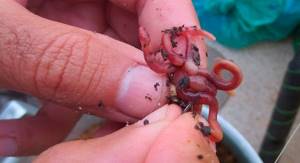
When fishing for perch, it is better to use dung worms about 5 cm long. You should not give preference to purchased worms, which stick well to the hook, but do not have a specific smell that attracts fish well.
When hooked, the worm should be pierced in several places, while the 2-3 centimeter long tip should remain mobile, which will serve as an additional irritant for the fish.
What do perch bite on?
Most often, the striped predator can be caught with a worm, although some fishermen successfully practice fishing with maggots. It is advisable to place the whole worm on the hook; to catch large trophy specimens you will need a bunch of “living creatures”. Advice! Pierce the worms in several places before placing them on the hook. The smell of the bait spreads quickly in the water and causes an immediate reaction from the predator. In October, perch’s attention can be attracted by its natural food – small fish or live bait. When fishing with fry, they are hung on a single hook or tee. The following inhabitants of reservoirs can be used as live bait: • gudgeon; • bleak; • rudd; • perched water; • small crucian carp.
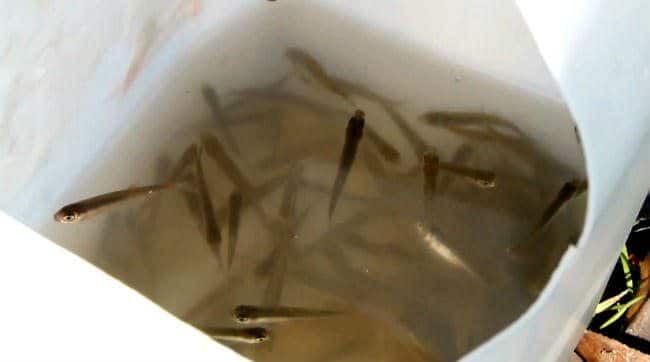
During summer fishing with live bait, small fish are chosen, this is especially true when hunting small predators. So the length of the crucian carp should not exceed 4 centimeters. When choosing live bait for perch, many fishermen prefer bleak, topwater or gudgeon. It is recommended to place the fry in the area of the dorsal fin. The sting of the hook can come out, the perch is not afraid of this. In such a case, the likelihood of catching a predator increases.
Catching perch with fry
The fry can be caught directly at the fishing site, using a special lift or a landing net with a fine mesh. It is better to use carp fish as bait:
- roach;
- bleak;
- rudd;
- crucian carp
The size of the bait for small and medium-sized predators should not exceed 5 cm. If there is a large perch in the reservoir chosen for fishing, you will need a small fish 7–10 cm long. To prevent the bait from flying off the hook during casting, the fish should be baited by passing the hook through its nostril. A special feature of the float rod equipment when fishing perch for fry is the length of the leash, which should be at least 50 cm. A long leash does not limit the movement of the fry, which makes the bait more attractive to the predator.
Fishing for perch near the mouths and on the coastal dump
Very promising areas for fishing for perch using a float rod will be the places where small tributaries flow into the river. Both white and predatory fish generally like to gather here. In such areas there are differences in depth, there is a current and the food supply is very rich. For perch there is a lot of fry, bottom food and other pleasant bonuses.
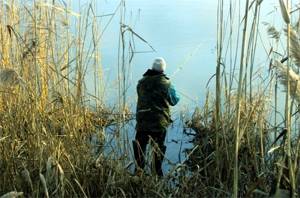
In such areas it is better to fish from a boat, since there are usually quite a lot of people on the shore. Perch fishing here is quite good. Schools quickly replace one another, so it is better to fish with one fishing rod. Practice has shown that this is the best option. The main bait will be a red worm, maggot and leech. Before you start fishing, it is important to find the edge so that the depth behind it is 3-4 meters.
When fishing on coastal dumps, you often have to deal with currents. In such cases, the fishing rod is turned into a half-bottom, as is the case when fishing near a bridge. The float is also moved closer to the top, and the leash is placed 40-50 cm long. In such gear, the float will not be on the water, but above it. Its function is only to indicate bites. It is not used to set depth. The weight and nozzle will lie on the bottom. That's why the tackle is called a half-bottom.
You can also fish with wire using this type of gear. By pulling the bait along the bottom, you can interest large perch. Leeches, caddis flies and crawlers are good baits. Good results can also be achieved using live bait.
Bait for perch
Baits for catching perch are made from dry beef blood. To be able to form bait balls, dry blood will need to be mixed with moistened soil in a 1:1 ratio. To increase efficiency, live components are added to the bait:
- chopped worm;
- bloodworm;
- maggot.
To attract “striped fish” to the fishing site, you can use bright trout baits containing not only amino acids and flavoring additives, but also sparkles that attract fish from afar.
Tricky tips for catching perch in summer
Here are a few more small but important tips:
- When fishing for perch, the wind should ideally blow at the angler's back. This will allow you to cast the bait further and feel the bite better;
- In reservoirs where fishing is more frequent, perch behaves more cautiously;
- If, when fishing at the same distance and the same depth, bites do not occur for a long time, then it is worth not only changing the place, but also the depth;
- When catching perch with a spinning rod, you should use a thin line, since this fish is predatory, which means it is very attentive and extremely careful.
Catching perch is a real test of a fisherman's professionalism. After all, only knowledge of its habits, favorite places and correctly selected tackle will help you return home with truly impressive trophies.
How to catch perch with a float rod
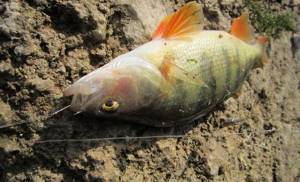
Arriving at a pond, the angler chooses the most promising place for fishing, prepares a bait mixture and sets up the tackle. Before setting the bait, the fisherman sets the release of the float so that the hook is 2–5 cm from the bottom. After setting the working depth, the angler baits the hook, throws the equipment and throws 2-3 balls of bait the size of an orange at the fishing point.
If within a few minutes the fish has not shown itself in any way, you should experiment with the fishing depth, reducing the descent of the float. If there is no bite, you need to change the type of bait. If manipulations with changing the fishing horizon and changing bait do not bring results, then you should move to another place.
Catching perch with a fishing rod is a constant experiment involving the search for the optimal composition of the bait mixture, selection of the required depth and choice of bait.
